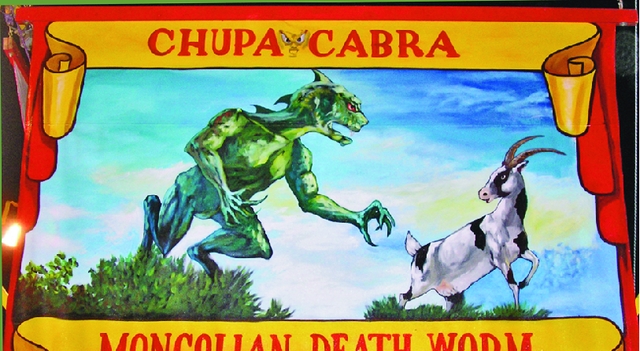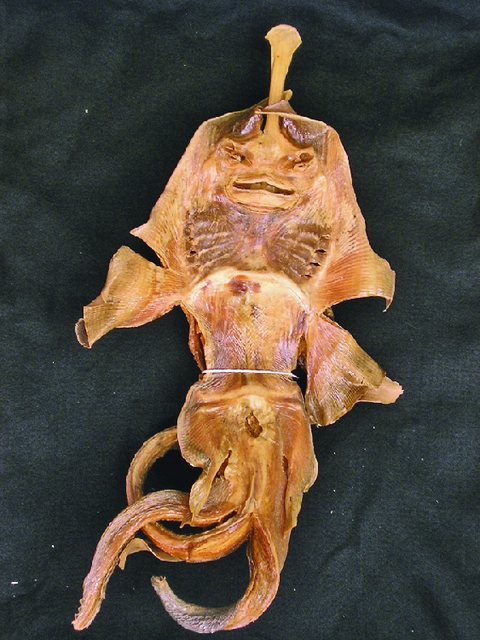In July 2007, a rancher in the small Texas town of Cuero captured a strange creature that had been attacking her livestock. She claimed the blue, hairless animal had been lurking around her ranch for years, and when it was hit by a car, she suggested she had finally captured a chupacabra, the vampiric goat-sucking monster of lore. Tissue samples were sent to biologists at Texas State University for DNA analysis, and while the rancher waited for the results she sold thousands of "2007: Summer of the Chupacabra" T-shirts and caps. New Mexico, of course, has its own chupacabra stories. Most are merely rumors and speculation about the fate of dead livestock, idle talk with no hard evidence. That is, until 2002, when a bizarre creature was found half-buried in the rocks and sand on the sun-baked West Mesa outside of Albuquerque. It wasn’t a dog or coyote. It wasn’t a bird or cow. In fact, it was unlike anything the finder had ever seen. The creature was dead but not rotting, nor was it a skeleton. Instead it was dried, almost as if the desert winds had carefully preserved the mystery. It had a vaguely human-like face, a pointy head, what seemed to be stubby wings and a long tail. The man who found it passed it along to his friend Bob Wheeler, who kept the curiosity and occasionally showed it to his friends and family “to freak them out.”One person thought it looked like a gargoyle; another suggested an alien. But Wheeler settled on his own identification: “[To people of] Spanish heritage, it’s the chupacabra,” Wheeler told a reporter from KOB Channel 4. “The goat sucker is what they call it." In February 2005, one of Wheeler’s friends suggested he ought to have professionals identify the creature. The remains were taken to Brian Gleadle of New Mexico’s Department of Game and Fish. Rio Rancho Journal writer Barbara Armijo reported the results on Feb. 12: “A creepy-looking skeleton found on the West Mesa several years ago is not the remains of the dreaded chupacabra, a mythical creature said to suck the blood from goats.”
Instead of a chupacabra, Gleadle said, the bizarre creature is a skate, an animal related to stingrays. Yet Gleadle’s explanation doesn’t complete the story, for he didn’t fully identify the crusty creature either. Gleadle offered an opinion as to the object’s origin: “It’s common for a slice of the actual wing to be used as a food source, and that’s what we believe was the case with this one … Someone had to have caught it in the ocean, most likely the Gulf of Mexico. They then probably cut the part that was edible and tossed the rest.”
Whether skate or chupacabra, the story had legs. Some mystery-mongering websites were quick to post stories and images of the creature, and it made the local news. KOB-TV’s website noted that “After doing some research, Eyewitness News 4 has concluded that the creature probably lived in the ocean at one time and probably isn’t either a chupacabra or an alien.”
When I saw the newspaper’s photograph of the ex-chupacabra, I immediately recognized it as a Devil Fish, also known as a
Jenny Haniver. It is in fact a cut-up, deformed and carefully dried skate; it was created as an oddity—essentially a faked monster. Jenny Hanivers date back more than 300 years and are sold in curio shops around the world but especially in the Caribbean. I have seen dozens of them in carnival sideshows, and in fact I own one.
But the mystery deepens: Why did an ocean animal end up on a desert mesa? A clue can be found in the newspaper’s photograph. The left “leg” of Wheeler’s creature was broken off at the “knee,” which probably explains why it was thrown away. The skate was never used for food; it would not have been specifically formed into a Jenny Haniver, nor would it have been so well-preserved if that had been the case. It was merely a damaged curio item, tossed out on the mesa instead of in the dump.
Wheeler’s identification of the Jenny Haniver as a chupacabra is instructive, since the remains look nothing like the typical descriptions of the vampiric beast. (It is far too small, for example, has “wings” and lacks spiny back ridges.) The chupacabra label was simply a catch-all name for “something strange I can’t identify.” This often happens in monster sightings, where any phenomenon that seems odd or inexplicable is “identified” as Bigfoot, or a lake monster, or a chupacabra.
The Cuero, Texas, chupacabra was also finally identified, the results made public just after Halloween: The strange, blue-hued creature was not a chupacabra, nor even a gray fox as some suggested. DNA sequencing revealed that it was instead a Texas coyote with a bad case of mange.
The Cuero and Westside chupacabras are only the latest of many strange-but-known finds over the years mistakenly labeled as mysterious creatures. In these cases—unlike the “real” chupacabra—we have the body; we have hard evidence. And, when hard evidence is available, we find an explanation.






